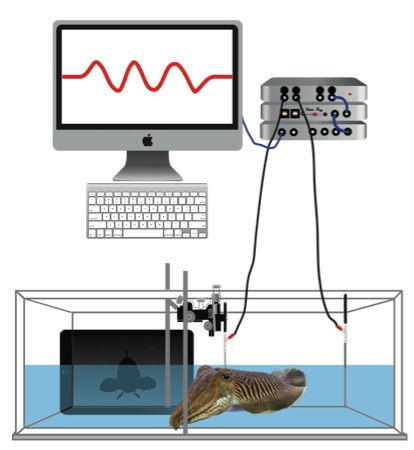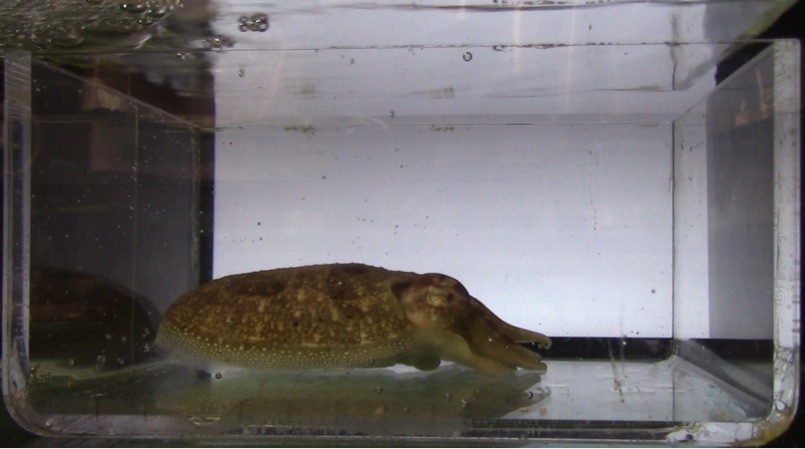Clever Cuttlefish 'Freeze' Bioelectric Fields to Avoid Predators
Cuttlefish are known for their ability to change colors, but these clever cephalopods have a problem: Sharks, rays and other predators hunt not only by sight, but by sensing the bioelectric fields emanating from their prey.
Now, new research reveals that cuttlefish have a solution to this problem: They turn down their natural electric fields by freezing in place and holding their breath.
This freeze response has not been studied as extensively as cephalopod color camouflage, or cuttlefish's response of releasing ink and jetting away from danger, said study researcher Christine Bedore, a biologist at Georgia Southern University.
Electric-field sensing "opens up the way we think about camouflage," Bedore told Live Science. [Cuttlefish Cuties: Photos of Color-Changing Cephalopods]
Natural electricity
All living animals give off natural electric fields just by existing. An EKG (electrocardiogram) at the doctor's office, for example, tracks heart rhythms by measuring the electrical signals that muscle cells send to each other. Sharks and their relatives are well attuned to these signals, Bedore said, and can detect a bioelectric field from prey from more than a foot and a half (half a meter) away. Even shark fetuses can detect a nearby electric field.

For the study, Bedore and her colleagues exposed captive-hatched cuttlefish of the species Sepia officinalis to the marine version of a horror film: video clips of fish and other predators looming toward them. They observed that cuttlefish froze, halting any movement, in response to these scary movies 80 percent of the time. The animals would drop to the bottom of their tanks, slow their breathing and close off the siphons and funnels they use to suck up and expel water as they swim. [Video: Watch Cuttlefish Evade Predators]
Sign up for the Live Science daily newsletter now
Get the world’s most fascinating discoveries delivered straight to your inbox.
By using electrodes placed next to the cuttlefish gills, the researchers found that the bioelectric signals from the cuttlefish varied between 10 and 30 millivolts when the animals were at rest. When the cuttlefish froze and covered their body openings, their electric fields dropped in voltage down to about 6 millivolts. (Electric eels produce bioelectric fields reaching 500 volts, the researchers noted.)
Successful strategy
Next, the researchers tested whether this drop in voltage affects sharks' ability to detect a cuttlefish in the water. They put wild-caught bonnethead sharks (Sphyrna tiburo) and young blacktip sharks (Carcharhinus limbatus) in tanks with small electrodes that were programmed to send out electrical signals mimicking those of cuttlefish at rest, of cuttlefish freezing, and of cuttlefish inking and jetting away (the latter activity raises the voltage of the animal's electric field fourfold).

Sharks bit at electrodes sending out the "freeze" signals only half as often as they bit at electrodes sending out the "at rest" signals, the researchers report today (Dec. 1) in the journal Proceedings of the Royal Society B.
"They were able to actually minimize the electric signals that are available to shark predators," Bedore said.
What's more, the cuttlefish seemed very smart about how they deployed this strategy. They were more likely to ink and jet away when Bedore was hovering over their tanks, adjusting equipment, than they were to freeze, she noticed. They were also less likely to freeze in response to videos of predators like crabs, which are relatively easy to swim away from. The decision to freeze or flee may depend on whether the cuttlefish thinks the predator has already spotted it, she said.
"Freezing is only going to work if the predator doesn't already know the cuttlefish is there," Bedore said.
Inking and jetting away can be a good way to flee, she said, but it isn't subtle. Sharks bit at electrodes mimicking a fleeing cuttlefish 94 percent of the time, and they seemed excited by the taste of cuttlefish ink in the water, Bedore said.
The next step, she said, is to study how visual camouflage and bioelectric camouflage act together to keep cuttlefish safe.
Follow Stephanie Pappas on Twitter and Google+. Follow us @livescience, Facebook & Google+. Original article on Live Science.

Stephanie Pappas is a contributing writer for Live Science, covering topics ranging from geoscience to archaeology to the human brain and behavior. She was previously a senior writer for Live Science but is now a freelancer based in Denver, Colorado, and regularly contributes to Scientific American and The Monitor, the monthly magazine of the American Psychological Association. Stephanie received a bachelor's degree in psychology from the University of South Carolina and a graduate certificate in science communication from the University of California, Santa Cruz.









